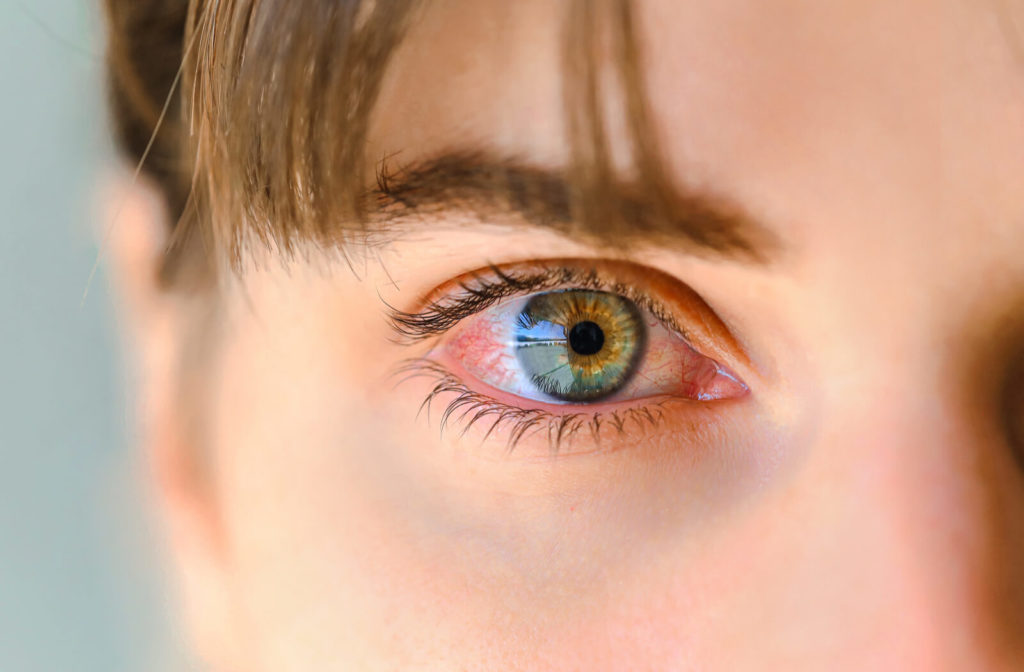A Checkup for Your Eyes
When you have a cold, you know to call your family doctor or a general practitioner for a checkup. But who do you call for eye problems? Your optometrist can help assess your sight, but do you know everything your optometrist can diagnose and treat?
Optometrists use eye exams to evaluate more than your visual abilities. They can also diagnose eye diseases and health conditions with ocular symptoms. Your optometrist can also help with eye allergies and infections, including pink eye.
What Is Pink Eye?
Pink eye or conjunctivitis is a condition causing swelling or inflammation of the conjunctiva. The conjunctiva is a thin, transparent tissue covering the whites of your eyes (the sclera) and inside your eyelids. When the conjunctiva is irritated, the blood vessels in the eyes dilate, leading to bloodshot eyes—the pink (or red) colour pink eye that pink eye is known for.
The conjunctiva protects your eyes and prevents debris and irritants from reaching the inner layers of the eye. It’s also the reason contact lenses can’t slip behind your eye.
Although pink eye is more common among children, the condition can affect any age group. Children experience conjunctivitis more often because young children are less cautious about rubbing their eyes with dirty hands.
While not all forms of conjunctivitis are contagious, pink eye is spread or contracted through close contact—either direct eye-touching or the area around the eyes.
There are 3 types of conjunctivitis:
- Allergic
- Chemical
- Infectious
In most cases, pink eye will not damage your eyes. However, it can develop into a severe condition, affecting eye health and sight when untreated. Symptoms of pink eye usually include:
- Burning or itchy eyes
- Discharge (stick yellow, watery, or stringy)
- Eyelid swelling
- Excessive tearing
- Light sensitivity
- Pink (or red) white of the eye(s)
Allergic or Chemical Conjunctivitis
Although allergic and chemic conjunctivitis have separate causes, they also share similarities. Neither type is infectious, and both are typically the result of an irritant reaching the eye.
Allergic Conjunctivitis
Allergic conjunctivitis is an allergen reaction. Instead of simply sneezing because of pollen, the reaction causes eye symptoms. Allergic pink eye is resolved when the allergen is removed, or allergies are treated.
Recurrent allergic pink eye may require additional treatment methods to improve comfort and alleviate symptoms.
Although allergic conjunctivitis isn’t curable, treatment can help manage symptoms and improve comfort. Some options include:
- Artificial tears to reduce itchy, watery, or red eyes
- Eyedrops with antihistamine and mast cell stabilizer
- Placing a clean cloth soaked in cold water over closed eyes
- Prescription allergy medications
Chemical Conjunctivitis
Chemical conjunctivitis is caused by a chemical irritant touching the eye. For example, perfumes, cleaning products, or airborne chemicals irritate the eye. But, the reaction resolves when the substances are flushed from the eye or exposure ceases. However, it’s crucial to receive emergency eye care when chemicals splash into your eye.
Contact the Eye Care Group for an emergency appointment after chemical exposure. We can help treat your eyes to prevent vision loss.

Infectious Conjunctivitis
There are 2 types of infectious pink eye: viral conjunctivitis and bacterial conjunctivitis.
Viral Conjunctivitis
Viral pink eye is commonly caused by adenoviruses, typically associated with the common cold. The virus can begin as an upper respiratory infection and move through the body’s mucous membranes, which connect to the lungs, throat, nose, and eyes. Viral pink eye infection can also be acquired through airborne exposure, such as coughing or sneezing.
The symptoms of viral pink eye are typically mild, often clearing up within 7–14 days. However, viral conjunctivitis can also last between 2–3 weeks. During that time, pink eye is highly contagious, and prolonged infection can increase the risk of harm.
Depending on the severity of the infection, your optometrist may prescribe antiviral medication or eyedrops. Your optometrist may also offer other treatment options, including artificial tears, antihistamine eye drops, warm compresses, or steroid eye drops.
Bacterial Conjunctivitis
Bacterial conjunctivitis occurs after direct eye contact with bacteria. Unclean hands, insect transmission, and contaminated facial products are common causes. Mild cases of bacterial pink eye can resolve within 2–5 days, but more severe forms can take longer to improve.
Using an antibiotic ointment (or eye drops) prescribed by your optometrist can improve recovery. It’s crucial to diagnose and treat bacterial conjunctivitis quickly to prevent worsening symptoms or spreading of the infection.
Pink Eye: Family Doctor vs Optometrist
Regardless of which medical professional you see, it’s crucial to have your pink eye assessed. Your family doctor can offer medical advice and treatment for conjunctivitis. But so can your optometrist. Many medical professionals are knowledgeable about eye anatomy and health, but optometrists have more specific knowledge.
An optometrist can evaluate the ocular surface and eye structures to determine the type of conjunctivitis and its effects on your eye health. Seeing your optometrist for a diagnosis and follow-up can also help prevent long-term effects on vision and eye health.
See the Eye Care Group for Pink Eye
Our friendly and experienced optometry team is always ready to discuss your eye care, including assessment for eye infections. The Eye Care Group is dedicated to creating a partnership with our patients as Edmonton eye doctors. You can trust us to provide an exceptional eye care experience.




